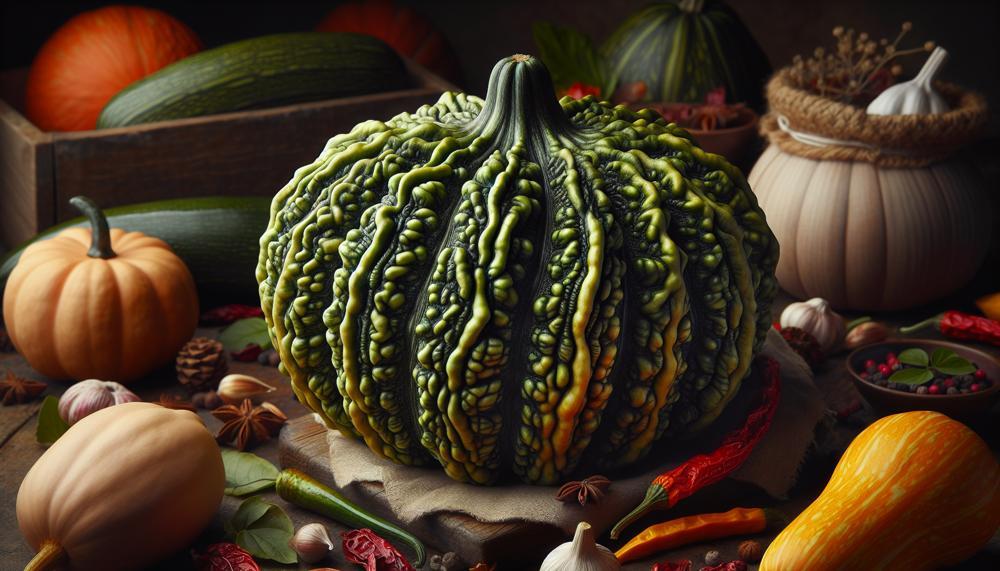Do you find yourself constantly disappointed by spoiled squash? You’re not alone. Nothing ruins a meal faster than discovering your squash has gone bad. But don’t give up on this delicious and versatile vegetable just yet.
In this blog post, we’ll dive into the world of squash spoilage and provide you with all the knowledge you need to prevent it from happening again.
In this post, we’ll cover:
- The visual cues of spoiled squash: From discoloration to mold, learn how to quickly identify a bad squash.
- The smell test: Did you know that spoiled squash has a distinct odor? We’ll teach you how to use your sense of smell to determine if your squash is still good.
- Texture changes: Discover the different textures that indicate spoilage in squash and what they mean.
- Proper storage techniques: Prevention is key. We’ll share tips on how to store your squash to extend its shelf life and avoid spoilage.
- Creative ways to salvage spoiled squash: Don’t let a bad squash go to waste. We’ll give you some ideas on how to transform it into delicious dishes.
Don’t let spoiled squash ruin your next meal. With our expert tips and tricks, you’ll become a pro at handling this beloved vegetable.
So keep reading and never waste another piece of squash again.
Contents
- 1 How To Tell if Yellow Squash Is Bad
- 2 How Long Is Yellow Squash Good For?
- 3 Can You Eat Yellow Squash That Has Bruises or Spots?
- 4 If Yellow Squash Has Scratches, Is It OK To Eat?
- 5 Can You Eat Yellow Squash With Bumps Safely?
- 6 Can You Eat Squishy Yellow Squash?
- 7 How Will Yellow Squash Smell if It Has Gone Bad?
- 8 What is the Difference Between Yellow and Green Squash?
- 9 What Happens if You Consume Spoiled Squash?
- 10 Conclusion
How To Tell if Yellow Squash Is Bad
Determining the safety of yellow squash and identifying any signs of spoilage can be accomplished through various methods.
Follow these steps to ensure safe consumption:
Inspect the appearance
Begin by examining the outer appearance of the squash. Look for any unusual markings, soft spots, or discoloration on the skin.
If the skin appears dull or dry, it may be an indication that the squash is no longer fresh.
Use your sense of smell
Give the squash a quick sniff. Rancid squash will have a noticeable unpleasant odor. If you detect a foul scent, it’s best to dispose of the squash.
Check the texture
Gently press on the squash with your fingers. A fresh squash should feel firm and slightly springy to the touch.
If it feels mushy or rubbery, it may have gone bad.
Look for mold growth
Mold is a clear indication that the squash has spoiled and should not be consumed.
If you notice any visible mold on the skin or flesh of the squash, it’s best to discard it.
Examine for pest infestation
Another sign of spoilage is the presence of insects or pests on the surface of the squash.
This can also pose a health risk if consumed.
Consider its weight
A fresh squash will feel heavy for its size due to its high water content.
If the squash feels light, it could be an indication that it has dried out and is no longer safe to eat.
Test a small amount
As a final step, you can taste a small portion of the squash to determine if it is still edible.
If it has a bitter or unpleasant taste, it’s best to dispose of it.
How Long Is Yellow Squash Good For?
Yellow squash typically has a shelf life of 3 to 4 days if stored correctly. However, if you want to increase its lifespan, you can store it in an airtight container in the fridge for up to a week.
To determine if yellow squash has spoiled, there are several important things to consider. First and foremost, check for any visible signs of mold. If you notice any, it’s best to throw out the squash as consuming mold can lead to health complications.
Next, examine the texture of the squash. It should feel firm when touched. If it feels soft or mushy, it may have gone bad and should not be consumed.
Inspect the skin of the squash for any signs of damage, such as cuts, bruises, or punctures. Fresh yellow squash should have smooth and unblemished skin. Any visible holes or punctures could indicate spoilage.
In addition, pay attention to the smell of the squash. Fresh yellow squash should have a mild and fresh aroma. If it has a strong or unpleasant smell, it is likely spoiled and should not be eaten.
Can You Eat Yellow Squash That Has Bruises or Spots?
No, it is not recommended to consume yellow squash that shows signs of physical damage or bacterial growth. This can lead to food poisoning and other health issues.
Therefore, it is important to carefully examine and store yellow squash to ensure its freshness and safety.
INDICATIONS OF SPOILED YELLOW SQUASH:
- Bruises or spots: These marks may indicate physical harm or bacterial contamination on the squash. Bacteria can enter through cuts and bruises on the squash, quickly spreading and causing the vegetable to spoil.
- Mold: If you notice any fuzzy, green, or black spots on the skin of your yellow squash, it is best to discard the entire vegetable. Mold is a sign that the squash has been contaminated with bacteria or fungi, which can cause foodborne illness.
- Softness: Yellow squash should have a firm and slightly shiny skin. If you notice any soft spots or areas on the skin that sink in when pressed, it is a sign that the squash is starting to spoil.
- Smell: Fresh yellow squash should have a mild and slightly sweet aroma. However, if you detect a strong, unpleasant odor coming from your squash, it is likely spoiled and should not be consumed.
STORING YELLOW SQUASH:
To prevent spoilage and extend the shelf life of your yellow squash, proper storage is crucial. Here are some tips for storing yellow squash:
- Refrigerate immediately: As soon as you purchase or harvest yellow squash, place it in the fridge. Leaving it at room temperature can accelerate the deterioration process.
- Store in the crisper drawer: The crisper drawer in your fridge provides a cool and humid environment that is ideal for storing yellow squash. Keep the vegetable in a perforated plastic bag or wrap it in paper towels to absorb excess moisture.
- Do not wash before storing: Yellow squash should not be washed before refrigerating. Exposing it to water can promote bacterial growth and cause it to spoil faster.
- Use within a week: To ensure the best taste and texture, it is recommended to use yellow squash within a week of purchase or harvest. Signs of spoilage can start to appear within two weeks of refrigeration.
If Yellow Squash Has Scratches, Is It OK To Eat?
Scratches on yellow squash can be a sign of spoilage, making it unsafe to consume. If you come across scratches on the surface of your yellow squash, it is best to refrain from eating it. This is because the scratches can create an opening for harmful bacteria and other microorganisms to enter, leading to spoilage and potential foodborne illnesses.
If you are unsure about the depth of the scratches and whether they can cause spoilage, it is best to discard the squash to avoid any risks. It is always better to take precautions when it comes to food safety.
Can You Eat Yellow Squash With Bumps Safely?
While bumps on yellow squash may not be visually appealing, they are typically safe to consume. However, it is important to note that there are potential risks associated with eating squash with bumps.
One risk is the presence of the mosaic virus, which can cause bumps and discoloration on squash and melons. Although this virus does not pose a threat to human health, it can alter the texture and taste of the squash. In severe cases, the bumps may make the squash less desirable for consumption.
Another risk to consider is rapid growth or an infestation of boring insects in the squash plant. This can result in lumpy and misshapen squash, which may not look appealing but is still safe to eat.
Furthermore, excess calcium in the soil can also contribute to bumps and deformities on squash plants. This mineral imbalance can cause growth abnormalities in the vegetable, but it does not make it unsafe for consumption.
To determine if a yellow squash with bumps is safe to eat, it is crucial to inspect the overall quality of the vegetable. If there are no signs of mold or spoilage and the flesh appears firm and fresh, it is likely safe to consume.
Additionally, if you are growing your own squash, ensure that you are properly storing them to prevent any potential risks such as cross-pollination.
Can You Eat Squishy Yellow Squash?
Squishy yellow squash may not be the most visually appealing vegetable, but it is generally safe for consumption.
However, there are a few factors to consider before indulging in this buttery and mild-flavored vegetable.
Risks to Consider:
- Mosaic Virus: Yellow squash that appears squishy may be infected with the mosaic virus, a common plant disease caused by a virus that can result in bumps and deformities on the skin of the squash. While this virus is not harmful to humans, it can affect the texture and taste of the vegetable. To ensure a pleasant dining experience, it is best to avoid consuming squash with severe symptoms of the mosaic virus.
- Insect Infestations: Squishy yellow squash may also be an indication of insect infestations, such as squash bugs or squash vine borers. These pests can cause damage to the vegetable and may also carry harmful bacteria. It is crucial to thoroughly inspect the squash before eating it and discard any that show signs of insect infestation.
- Seed Toxicity: The seeds of yellow squash contain a toxin called solanine, which can cause gastrointestinal issues like vomiting and diarrhea if consumed in large amounts. To avoid any unwanted stomach troubles, it is best to remove and discard the seeds before cooking or eating yellow squash.
| Refrigerator | Freezer | |
| Yellow Squash (fresh) | 3-5 days | Up to 6 months |
| Yellow Squash (cooked) | 3-5 days | Up to 6 months |
How Will Yellow Squash Smell if It Has Gone Bad?
When yellow squash goes bad, its scent can become drastically different. This is because bacteria and fungi break down the organic matter, releasing pungent compounds that emit undesirable smells.
The specific odor may vary depending on the type of bacteria or fungi present, but it is generally described as a powerful, rotten or moldy smell.

| Refrigerator | Countertop | |
| Yellow squash (fresh) | 5 to 7 days | 1 to 2 days |
| Yellow squash (cooked) | 5 to 7 days | 3 to 4 days |
If you detect a strong, unpleasant aroma when examining your yellow squash, it is likely that it has spoiled and should be disposed of. This is particularly true if the squash is also mushy to the touch or shows visible signs of mold growth.
Even if there are no apparent signs of spoilage, a very soft texture can indicate that the squash is no longer safe to consume.
What is the Difference Between Yellow and Green Squash?
Green and yellow squash may seem similar, but there are subtle differences that set them apart. While their colors are the main distinguishing factor, there are other characteristics that can help you differentiate between the two.
Shape and Texture:
Zucchini, the most popular type of green squash, has a straight shape and smooth skin. On the other hand, yellow squash has a curved shape with a more textured exterior. The bottom of yellow squash is thicker and tapers towards the top, while zucchini maintains a consistent width throughout.
Taste and Flavor:
Both types of squash have a mild and slightly sweet flavor, but they differ in taste. Zucchini has a nutty and firm texture when cooked, making it a great addition to pasta dishes or baked goods. Meanwhile, yellow squash has a softer and sweeter taste when cooked, making it perfect for grilling or sautéing.
Uses in Cooking:
Zucchini and yellow squash can be used interchangeably in cooking, but each has its own strengths. Zucchini retains its firm texture when cooked, making it ideal for dishes like pasta or casseroles. On the other hand, yellow squash becomes softer and sweeter when cooked, making it a great choice for grilling or sautéing.
In conclusion, while both types of squash have similarities in terms of characteristics and uses in cooking, they can be distinguished by their color, shape, texture, and taste.
What Happens if You Consume Spoiled Squash?
Eating spoiled squash can significantly impact your health in a detrimental way. Consuming spoiled squash can result in food poisoning, caused by consuming food containing harmful bacteria or toxins. When squash spoils, it begins to develop bacteria that can produce toxins, leading to a type of food poisoning known as toxic squash syndrome.
Symptoms of toxic squash syndrome include:
- Nausea
- Vomiting
- Diarrhea
- Abdominal pain
- Headaches
- Fever
These symptoms can range from mild to severe and may last anywhere from a few hours to several days. If you experience any of these symptoms after eating spoiled squash, it is crucial to seek immediate medical attention.
To prevent food poisoning and other foodborne illnesses, it is crucial to properly store and handle fresh produce. Be sure to check for any signs of spoilage before consuming squash, such as mold, discoloration, or a foul smell. If you are uncertain if the squash is safe to eat, it is always best to err on the side of caution and discard it.
Storing squash in the refrigerator can also help prevent spoilage. However, even when stored correctly, squash has a relatively short shelf life and should be consumed within 3-5 days of purchase.
| Type of Squash | Refrigerator Storage Time | Freezer Storage Time |
| Fresh Squash | 3-5 days | 6-8 months |
| Cooked Squash | 3-5 days | 6 months |
In addition to properly storing and handling squash, it is crucial to cook it thoroughly before consuming. Cooking can help kill any harmful bacteria that may be present and reduce the risk of food poisoning.
Conclusion
In conclusion, being able to identify the signs of spoilage and taking proper storage measures is key to preventing spoiled squash.
By visually inspecting its appearance, using your sense of smell, checking for changes in texture, and being mindful of storage techniques, you can easily determine if your yellow squash has gone bad. And if it does happen to spoil, don’t let it go to waste.
Get creative with ways to salvage it into delicious dishes. With these expert tips and tricks, you’ll never have to be disappointed by spoiled squash again.




